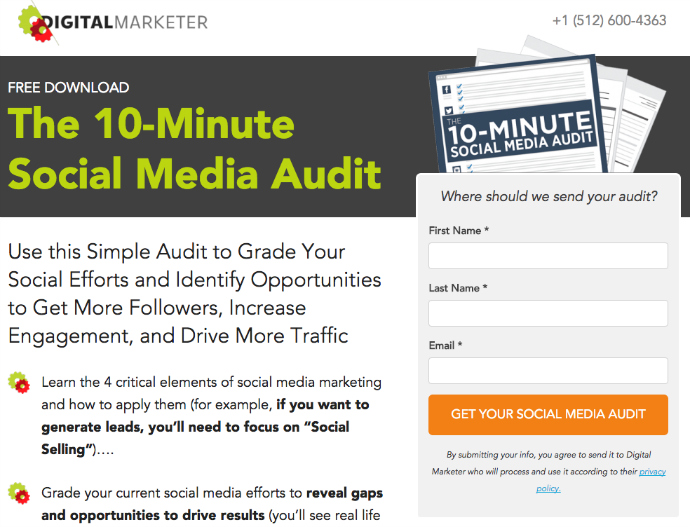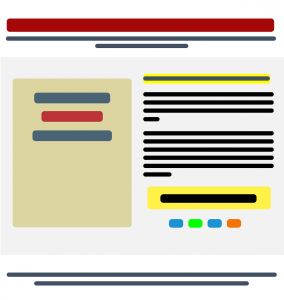A landing page is a web page that visitors first see after clicking a link. Typically, the link is from a marketing effort, such as PPC or banner advertisement. In most cases, a landing page is not, nor should be, the home page for the main website. You want your visitors to see a page that describes the product or service advertised, and your generalized home page may not fit the bill precisely.
Any webpage on your site could be a potential landing page. The Google Learning Center describes a good landing page for AdWords as one that is:
- Useful and relevant
- Easy to navigate
The visitors who click on an ad or other text link expect to see content that resembles the link. Your landing page should contain relevant content for the visitor, or else they are likely to click away immediately in frustration. Your landing page should have useful information about the product or service that interested your visitor to click the link in the first place.
Avoid Using Your Homepage as the Landing Page
A homepage used as a landing page can further confuse your visitors. They clicked on your link or ad because of specific information, and if they are presented with a homepage containing general content and navigation, they are forced to search for the information. This could further frustrate your visitors and turn them away from your site. Subsequently, it is wise to use an existing page that has the relevant information, or better yet, create a completely separate web page as a landing page.
Why Create a Separate Landing Page?
A separate landing page created specifically for your ad text or link provides benefits to both you and your visitors in several ways:
Track advertising landing clicks
If you are purchasing links for AdWords, banner ads, or other marketing efforts, you may want to track how effective each campaign is. A separate landing page can help you obtain statistical data about your visitors, such as where they click from, how long they stay, and whether they convert into customers. By measuring the effectiveness (or ineffectiveness) of your ad campaign, you can make changes or alterations as needed to improve your conversion rate.
Focus your advertising content
If you have attracted visitors from an advertising link, they want to learn more about a specific product or service. Deterring your visitors to a landing page with different content than promised on your ad link is sneaky, deceitful, and unethical, and it could ultimately get your website banned from search engines. For instance, if your banner ad promotes a free report about losing weight, but visitors are sent to a landing page filled with discount electronics, you have deceived your visitors.
Rather, you want to provide highly focused content in the form of images and text that will further solicit a response from your visitors. A separate landing page allows you to create focused content without altering your regular website navigation.
Capture lead data
A landing page can be used to solicit information from your visitors before presenting them with promised information. However, be careful about how much personal information you request. Usually, an email address is sufficient for a lead, and most visitors will not mind providing just their email to receive more information.
Unconventional testing
A landing page may also be used to test an unconventional marketing strategy for a product or service. Try a landing page with no navigational menu, but rather just basic information you want your reader to know and a form for readers to complete before reading further. Conversion rates have proven to be more successful with this type of unconventional landing page that does not present navigational buttons.
Other landing page testing could include a countdown for the reader to respond, which creates a sense of urgency. Validate your website’s credibility with landing pages that present testimonials and images of secure credit card logos.
You can also consider testing different sales through landing pages. For example, would a percentage discount or a dollar discount be most effective for your product?
If your business model focuses on garnering subscribers, then you can test landing pages that incorporate different elements, including:
- Surprises bonuses for a subscription
- Incorporating an image of a secured lock at the “sign up” button
- Include phone contact information to increase your website’s legitimacy
- Utilize a live chat function on the landing page
If you want to try something different on your website, a landing page is a great way to test it.
Powerful Landing Page Elements

- Consistent Look and Design – A landing page should share consistent elements with your regular website, especially if you eventually redirect your visitors there. Your landing page design will help with building credibility, especially if visitors see that the information is exactly what was promised from the ad link.
- Images – A page with attractive graphical photos and images can greatly help in converting clickers to customers. Images add that element of credibility and reality on a web page that readers can see, such as an attractive young successful model enjoying your product. However, choose images carefully and don’t overload your landing page with too many.
- Write Riveting Copy – The copywriting on your landing page should be focused, persuasive, and easy to read. Break paragraphs into two or three sentences. Use headings and subheadings to make reading navigation easy to follow. Bullet points can emphasize certain points that you want your readers to know.
- Most importantly, your copy should be tightly focused and make the reader want to read more. It’s all about your reader. Provide them with how your product or service will benefit them. Don’t fill a landing page with how great your company or website is. Keep the copy riveting and motivating.
- Call To Action – Ultimately, you want your landing page to result in a conversion, meaning, you make a sale or gather needed information from a visitor. A well designed and well-written landing page can result in an automatic sale. Make sure your visitors know what they need to do. Provide them with sufficient calls to action using text links or graphic buttons.
- Optimized for Searches – Your landing page can be found from natural searches in addition to paid ads and links. Design your landing page with the search engines in mind. Use keywords in your subheadings, text body, and within normal HTML meta tags.
However, remember not to overdo your keyword density, as search engine technology can detect deceitful SEO tricks such as keyword stuffing. A well-designed landing page that utilizes normal use of keywords and content can result in additional visitors from search engines.
Resources:
http://www.google.com/adwords/learningcenter/text/19428.html
http://www.netmechanic.com/news/vol8/promo_no3.htm
http://www.copyblogger.com/seal-the-deal-10-tips-for-writing-the-ultimate-landing-page/
